Rising petroleum costs to see plastic price spike
NACD announces food packages of the year
Philippine agency packaging rice to stop hoarding
Cookies come in break-apart cups
Cereal canisters are slim and reclosable

by Lisa McTigue Pierce, Editor-in-Chief
Yes, you can create packaging that is functional, appealing, survives supply chains and is generally seen as innovative-and it can be environmentally friendly, too. Here’s proof.
Last Thursday, 10 companies won awards and recognition in the prestigious 20th Annual DuPont Awards for Packaging Innovation at a presentation dinner held at the elegant and serene Longwood Gardens horticulture showplace in Kennett Square, Pa.
For the past 19 years, this independently judged competition has honored innovations in packaging. For its 20th anniversary, DuPont decided to put a slightly new spin on the competition. This year, it specifically focused on sustainable packaging innovations that also meet important market requirements, such as enhanced performance, convenience and shelf impact.
But, deliberately, nowhere in the judging criteria will you see the word “sustainability.” Jurors evaluated entries based on how innovative they were in these seven factors: (1) clean production; (2) effective recovery; (3) community/social benefit; (4) enhanced performance; (5) cost-effective economics; (6) responsible sourcing; and (7) resource and energy optimization.
Four of the 12 jurors (see list below) spoke about the selection criteria and judging process during a panel discussion just hours before the awards presentation. Among their comments were these insights:
Sustainability is a relatively new term in packaging and it means different things to different people. “That’s why we deliberately didn’t use the word in the judging criteria,” explained Jason Pearson, president/CEO, GreenBlue.
One of the reasons it made sense for the DuPont Awards to focus on innovations in sustainable packaging this year is that, according to Julian Carroll, managing director of Europen, “Sustainability and packaging have become mainstream.”
Even though packaging is often the most visible and criticized component of product waste, Brian Wagner, VP/COO of Packaging & Technology Integrated Solutions LLC, said, “Packaging is part of the solution. It’s the secret.”
Despite all the hype and greenwashing, many corporations have taken the lead in their social commitment to sustainability. John Bernardo, founder of Sustainable Innovations LLC, said, “It takes a lot of corporate and financial guts to say, ‘We’re going to change packaging that’s been working for us and we’re going to look at something different.’ You have to just applaud the fact that the effort’s being made.”
And applaud we did, as each company’s delegate stepped up to the stage last week to accept an award.
Although this newsletter focuses on food packaging, we’re showing all the award and notable achievement recipients because these sustainable packaging innovations have broad use across many markets-and many regions. Notice how winners and judges alike reflect the global nature of packaging sustainability.
As usual, the competition was fierce. For two days, the jurors analyzed nearly 80 entries before awarding the following seven winners and three notables:
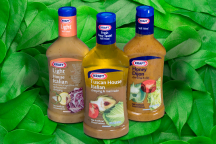
WINNERS:
1. Kraft Foods and Plastipak Packaging (USA)
Kraft optimized its Kraft Salad Dressings bottle by reducing its weight nearly 19%, improving transport efficiency 18% and conserving energy for distribution. Reported to be preferred by consumers, this ergonomic bottle retains the appeal of the iconic and trusted Kraft brand, while significantly improving its sustainability-and with no change in source materials. By working with bottle supplier Plastipak Packaging to refine the manufacturing process, Kraft was able to reduce the bottle weight and save more than three million pounds of plastic annually. The new design also allows more bottles to be shipped per truckload, so less energy is consumed in the supply chain. Additionally, new consumer conveniences include an easy-open flip top cap and a container that’s easier to hold, pour and store .

2. Larsen Danish Seafood and Faerch Plast (Denmark)
With food waste becoming a major sustainability issue in developed countries, this new AMPET single-portion retort pack for Larsen Danish Seafood keeps product fresh and reduces the food waste typically associated with larger portions of seafood in traditional ambient packaging. Recognized for resource and energy optimization, the pack’s logistics and storage benefits allow reduced energy use while matching the shelf-life standards of traditional materials. Its effective use of raw materials results in significant savings compared to traditional retortable materials. The used package is suitable for mechanical recycling or energy recovery.

Why would anyone want to deliberately cause delamination during bottle blow molding? To solve a customer’s problem, of course. That’s what CEO Roland Kneer did to produce a coextruded, blow molded bottle with a separate inner bag made with DuPont Surlyn. The AirLEssMotion Bag-in-Bottle System is currently being used for sterile disinfectant spray. The previous package required a four-part manufacturing and assembly process. Now it’s done in one step instead of four, and requires 50% less energy to make. Additionally, the AirLEssMotion Bag-in-Bottle System uses less raw material than the previous pack or other conventional container systems. Its unique design (including a series of well-placed air holes in the outer bottle only) creates internal pressure on the bag to improve product evacuation so less product is wasted, while preventing air or other contaminants from contacting the product. And, once the product is dispensed, the package is easier to dispose of because the bottle and bag belong to the same polymer family. The container design is currently being used with a spray dispenser, but Kneer says they’re working on being able to accommodate other dispensing closures. Although Kneer says they will next focus on the cosmetics market, I see tremendous potential for an airless dispensing system that is manufacturing-friendly for the food industry.
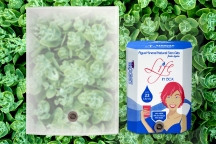
4. Lindóya Vida and Klabin (Brazil)
Most of us take clean drinking water for granted. But in remote areas in Brazil, it’s so scarce that they have to ship it in. The new Lindóya Vida’s Water Bag-in-Box provides an alternative to returnable rigid bottles that typically cost 40% more per liter, are more energy intensive to produce and are more liable to contamination. The outer corrugated box from Klabin is recyclable, and the lightweight inner liner can be recycled into other plastic components and is suitable for energy recovery. Lindóya Vida selected a polymer with good organoleptic properties for the liner (they declined to identify the polymer), which is critical to prevent the water (or any food, for that matter) from acquiring an off or bad taste due to the packaging.

5. Marks & Spencer, Plantic Technologies, Chocolat Frey and Stager (UK, Australia and Switzerland)
For its Swiss Chocolate Assortment, produced by Chocolat Frey, Marks & Spencer replaced traditional confectionary packaging inserts with a biodegradable tray from Stager that uses a renewable plant-based plastic from Plantic Technologies. This biodegradable and home-compostable solution allows consumers to choose the most appropriate end-of-life disposal based on local infrastructure. To educate consumers, disposal information is clearly communicated on the outer box, which is recyclable.
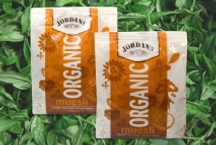
6. Jordans Cereals and Alcan Packaging (UK and Ireland)
A new compostable, biodegradable pouch supports natural branding of Jordans Organic Cereals and helps assure effective post-use recovery. From Alcan Packaging, this first-of-its-kind flexible package is made from renewable raw materials and can be composted at home or through industrial composting. This approach to effective recovery supports Jordan’s overall brand strategy and makes a meaningful contribution to reducing waste disposal and landfill requirements, while reducing the need for incineration.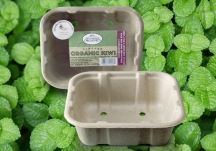
7. EarthCycle and Innovia Films (Canada, UK and Malaysia)
EarthCycle’s Organic Kiwi package uses only renewable and biodegradable materials in support of responsible sourcing, clean production and effective recovery. This compostable produce pack consists of three pieces: (1) The tray is made from palm fiber, a renewable resource, which would otherwise be a waste product. (2) The Natureflex film, from Innovia Films, is a transparent cellulose-based film made from renewable wood pulp sourced from managed plantations. (3) The label, also certified as home-compostable, uses water-based ink and a special adhesive that is compostable, too. This packaging simplifies responsible disposal and also supports the natural branding of organic produce.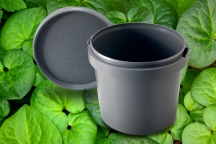
1. Superfos (Denmark)
One reason more types of plastics aren’t heavily recycled is because the supply of recycled material doesn’t warrant developing an entire recycling infrastructure. This innovation from Superfos may be the impetus to develop an infrastructure to recycle another plastic: polypropylene. The UniPak Eco is the first polypropylene container made of responsibly sourced 100% recyclable post-consumer recycled materials. It reduces waste by diverting PP from the landfill. Calculations indicate that the source material reduces the CO2 footprint by 20%, and the recyclable attributes reduce the CO2 footprint by more than 70%.
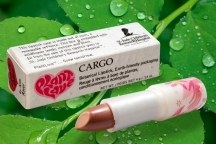
2. Cargo Cosmetics and NatureWorks LLC (Canada and U.S.A.)
Cargo Cosmetics’ PlantLove Lipstick applicator is made entirely of a single material for easier recycling. It also has the added benefit of using a renewable polymer, polylactic acid (PLA) from NatureWorks LLC. Through careful design, Cargo Cosmetics was able to control surface-to-surface friction between parts of the same material. Text on the carton, which is embedded with plant seeds and disintegrates when planted, educates consumers about responsible disposal of the entire package.
3. Promopack (UK)
Promopack, a digital design and production studio, is using a new thermal plate-making process that eliminates solvents for cleaner production in packaging graphics. The DuPont Cyrel FAST (www2.dupont.com/Packaging_Graphics/en_US/) solvent-free plate-making process also creates a more consistent, better quality, longer-lasting printing plate. FAST plates also significantly reduce overall press time and labor.Top Developments
Rising petroleum costs to see plastic price spikeDue to rising petroleum costs, the price of high density polyethylene (HDPE), used to make milk bottles, is up 144%, and the price of polyethylene terephthalate (PET), used for soft-drink and water bottles, is up 65%, possibly forcing some companies facing shrinking profit margins to raise prices and hope customers keep buying products. Other companies will try logistics, sourcing and shipping changes before price increases, as well as package design changes, such as making water and pop bottles with thinner plastic, or substituting waxboard for ice cream cartons. However, the struggling economy has forced some companies, such as General Electric and Dow Chemical, to sell part or all of their plastic businesses.
NACD announces food packages of the year
The National Association of Container Distributors (NACD) Package of the Year awards were given on April 4 during the association’s 2008 Annual Convention in Naples, Fla. The two food packages that walked away with awards were General Mills’ Cheerios Tot Pack, supplied by Continental Packaging Solutions, which won gold in the Food & Beverage category; and Eillien’s Santa & Snowman Butter Toffee Canister, supplied by WB Bottle Supply Co., which walked away with bronze in the Novelty category.
Philippine agency packaging rice to stop hoarding
Beginning next month, the National Food Authority (NFA) will repackage subsidized rice in the Philippines to prevent hoarding. The NFA will repack rice into smaller one-, two- and three-kilogram bags to keep traders from either repacking NFA rice as commercial rice or mixing it with a higher-quality variety and selling it at a higher price. Retailers will no longer be able to pick up rice stocks at NFA warehouses, as well, but will have rice directly delivered to their establishments.
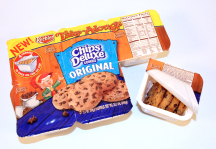
New Packages
Cookies come in break-apart cupsTwo flavors of cookies from the Keebler unit of the Kellogg Co. now come in break-apart cups. Take-Alongs for Chips Deluxe chocolate-chip and Sandies shortbread cookies comprise six cups in a 2 x 3 grid, with four cookies per cup. The polypropylene cups are joined and perforated along their edges, allowing consumers to break off a single cup. Flexible polyester lidding, also perforated, forms a continuous billboard surface.
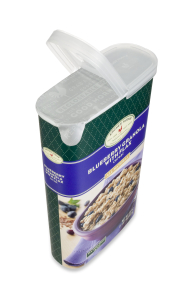
Target Corp. has brought out a reclosable canister for its Archer Farms store brand ready-to-eat cereal. The canister, made in part with recycled paperboard, features a reclosable easy-flow spout and snap-shut plastic lid over a foil seal. The oblong canister has a slim design-10 inches tall and 1.5 inches deep-to minimize the space required for storage. The canisters, rolled out this month, are available in 18 flavor combinations such as Triple Berry Clusters, Vanilla Spice Squares, Banana Walnut Bliss, Pecan Sticky Bun and Blueberry Flax, ranging in price from $3.49 to $3.99.
